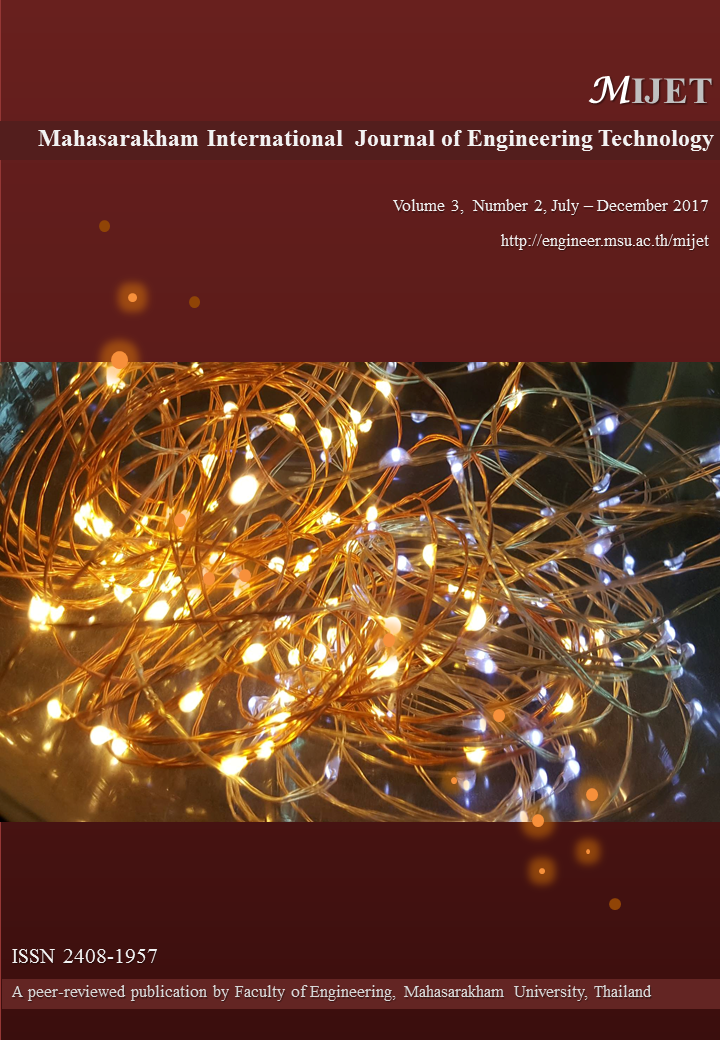Water Permeability of Concrete after Exposed to High Temperatures
doi: 10.14456/mijet.2017.9
Keywords:
fly ash, concrete, high temperature, compressive strength, water permeabilityAbstract
The water permeability of fly ash concrete after exposed to high temperatures was investigated in this research. The fly ash samples were represented as the fire building and the deterioration of concrete as evaluated in terms of compressive strength and water permeability were tested and measured. High fineness fly ash was used to replace Portland cement Type I at 10, 20 and 30% by weight of binder. The 90-day concrete samples were heated at 200, 300 and 400 degrees Celsius for each test in the electric chamber for 60 minutes. Suddenly, the concrete samples were rapid cool down in water bath. Compressive strength and water permeability were processed. The experimental results showed that the compressive strength of fly ash concrete with the replacement up to 30% was higher than the ordinary concrete. The compressive strength was reduced when the exposure temperature was increased. For the water permeability, the unheated samples of fly ash concrete gave the lower value than the ordinary concrete. However, when temperature increased, the fly ash concrete had more permeation than the ordinary concrete sample; even the compressive strength was higher.
References
[2]Oktar, O.N. Moral, H. Tasdemir, M.A., Factors determining the correlation between concrete properties, Cement and Concrete Research, 1996, Vo.26, pp.1629-1637.
[3] Lin, W.M. Lin, T.D. and Powers-Couche, L.J., Microstructures of fire-damaged concrete, ACI Materials Journal, 1996, Vo.93, pp.199-205.
[4] Chindaprasirt, P. Jaturapitakkul, C. and Sinsiri, T., Effect of fly ash fineness on compressive strength and pore size of blended cement past, Cement Concrete Composite, 2005Vo.27, No.4, p.425.
[5]Erdogdu, K. and Turker, P., Effects of fly ash particle size on strength of Portland cement fly ash mortars, Cement and Concrete Research, 1998, Vo.28, No.4, p.1217.
[6]Janotka, I. Nurnbergerova, T., Effect of temperature on structural quality of the cement paste and high-strength concrete with silica fume, Nuclear Engineering and Design, 2005 Vo.235, p.2019–2032.
[7] Khatri, R.P. and Sirivivatnanon, V., Methods of the determination of water permeability of concrete, ACI Materials .Journal, 1997, Vo.94, No.3, p. 257-264.
[8] Concrete Society, Permeability testing of site concrete, a review of methods and experience, The concrete society, Report, 1987, Vo.31, p.89-94.
[9] Chindaprasirt, P. Homwuttiwong, S. Sirivivatnanon, V., Influence of fly ash fineness on strength, drying shrinkage and sulfate resistance of blended cement mortar, Cement and Concrete Research, 2004, Vo.34, p. 1087–1092.
[10] Chindaprasirt, P. Jaturapitakkula, C. Sinsiri, T. Effect of fly ash fineness on compressive strength and pore size of blended cement paste, Cement Concrete Composites, 2005, Vo.27 p. 425–428.
[11] Tangpagasita, J. Cheerarot, R. Jaturapitakkula, C. Kiattikomol, k., Packing effect and pozzolanic reaction of fly ash in mortar, Cement and Concrete Research, 2005, Vo.35, p. 1145–1151.
Downloads
Published
How to Cite
Issue
Section
License
Copyright (c) 2017 Mahasarakham International Journal of Engineering Technology

This work is licensed under a Creative Commons Attribution-NonCommercial-NoDerivatives 4.0 International License.








